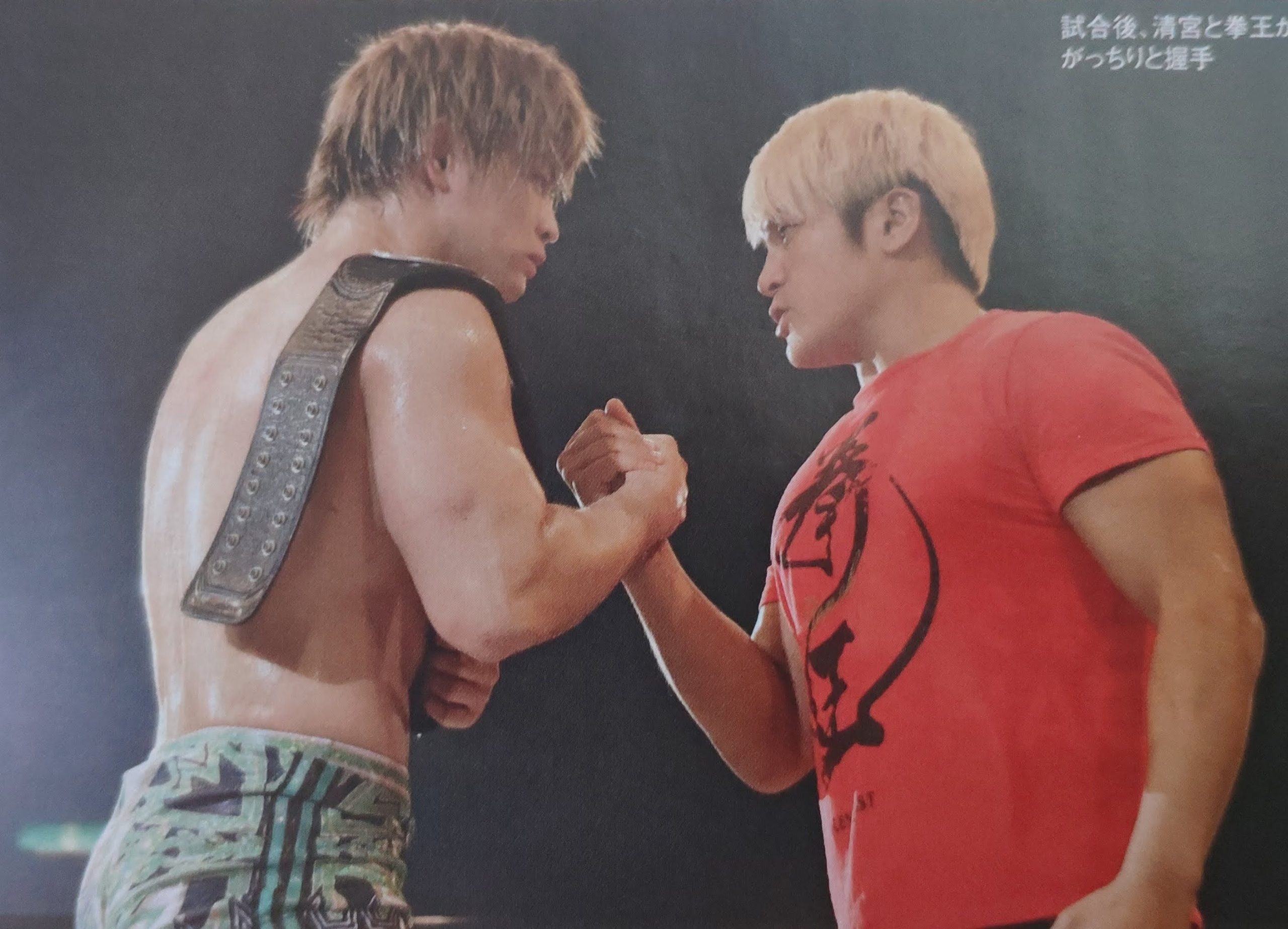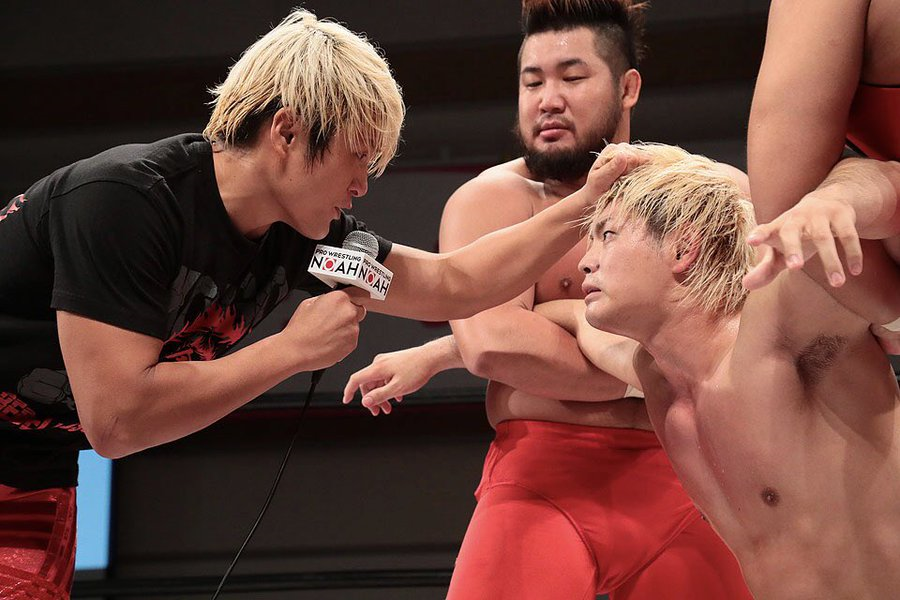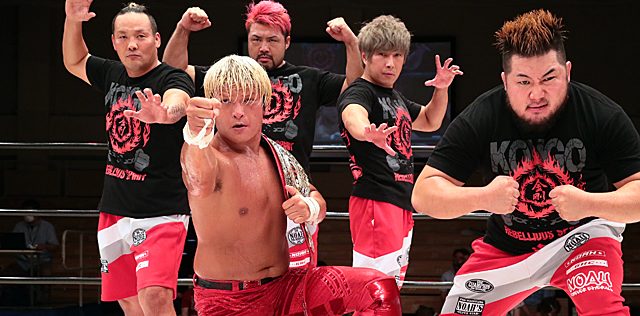In Pro Wrestling, like in other mediums, part of the key to success is not going unnoticed. Making our presence felt in some way. There is one wrestler out there, vowing to change the hierarchy for years, now taking this statement to a whole other level. His name is Kenoh, and here we will dive deep into his growing importance within and beyond Pro Wrestling NOAH over time.
2017-2018: The rise, fall and establishing a mentality.
From wishing to be acknowledged to ultimately surpassing your peers is no easy task. When Kenoh decided it was time to go against Heavyweights in NOAH on the regular, his rise was quick. 2017 saw him claim the Heavyweight tag titles twice, alongside longtime (former and future) stablemate Masa Kitamiya, and then with a key mentor figure (at the time) in Takashi Sugiura. Those reigns did not last long, but they helped propel Kenoh towards the top, as by Christmas Day he had also won both the Global League tournament AND the GHC Heavyweight title.
Yet, Kenoh’s first reign on top was short-lived, as it was Sugiura himself who ended it the following April. Kenoh, followed by the rest of the younger generation of NOAH Heavyweights, would declare Sugiura and the “past” generation as enemies and a generational war ensued. Sugiura dominated for most of the year, with neither Kenoh nor anyone else able to claim the title from him, but it became clearer as time went by that the future was there and hungry for success. A future with Kenoh at the helm, or so he thought.
Similarly to Kenoh a year prior, Kaito Kiyomiya ascended quickly in 2018. From challenging Kenoh for the Heavyweight title, being mentored by Go Shiozaki and claiming tag gold with him, all the way to Global League and GHC Heavyweight glory. The future had arrived, a “Supernova” which was destined to light the way towards a bright future for NOAH. Although Kenoh was a crucial part of making sure Kaito shone brightly, Kaito’s rise cast him at the foil to the Ace, not NOAH’s leading man.
Now, not all was done in vain as Kenoh did start what would become a far larger campaign as time goes by. Though he did not quite kickstart the youth movement in NOAH, he contributed significantly to pushing it forward, both directly and indirectly.
After all, none other than Kenoh has pushed Kiyomiya more since the latter’s beginnings, posing as a rival to surpass early on, in a reminiscing yet unique way compared to what Sugiura has been to him.
2019-2021: Kongo and growing into a pillar.
2019 is the year where everything truly started to kick in for Kenoh, both as an individual and regarding his goals. Prior to this however, Kaito Kiyomiya, the GHC Heavyweight champion, had to be further tested following his victory over Sugiura. Therefore, as the new year kicked off, Kiyomiya defended his title against Kenoh, the first of a total six successful defenses over the course of the year. That one title defense also cemented Kenoh as the measuring stick regarding Kiyomiya’s growth, tying them together yet further.

Speaking of Kiyomiya’s growth and Kenoh playing a big part in it: As the 2019 Global Tag League kicked off, the two men decided to team up. Both Kenoh and Kiyomiya were, and still are, ultimately wishing for the same thing: Bringing NOAH back to the forefront. It made sense then to pair up, as they were fighting towards the same goal and, at that point, were essentially standing on their own. While their run together in the tournament was far from bad, coming just short of reaching the finals, they could not win, and Kenoh decided that teaming up was not the road to take. So he left Kiyomiya’s side. That short arc of their story tells us one thing: As good of a pairing they could have been, and probably could still be, their entire dynamic simply works better as they each walk a path of their own.
As for Kenoh specifically, he had already understood that standing on his own would not be helpful. After all, Go Shiozaki and Katsuhiko Nakajima were now teaming up as AXIZ, and maybe more importantly, Takashi Sugiura was forming a unit of his own in Sugiura-Gun. Hence Kenoh reacting and forming one himself: Kongo. Now Kenoh was a faction leader in NOAH, following a previous stint as part of Takeshi Morishima’s Cho Kibô-Gun, and more importantly having formed a group of his own in Michinoku Pro in the past, going by the name of Asura. That past experience surely helped in shaping Kongo as we know it, both as a group and a concept.
From the start, Kongo was very representative of his leader. At that point, all major figures in NOAH were trying to figure out a new direction to go following the generational war, yet the remnants of that previous arc were not quite gone. The younger Heavyweights mostly remained together, and the older ones did the same. That particular aspect of NOAH during 2019 was reflected through the continuous feud, still existing to this day, between Kongo and Sugiura-Gun. The fight to cement the younger generation at the top of NOAH was just kicking another gear.
Kenoh saw his unit become a group of four individuals, as a longtime partner in Masa Kitamiya, another Junior trying to make strides as a Heavyweight in Atsushi Kotoge and the super rookie Yoshiki Inamura all joined his side. All of them had something to prove and were walking a similar path to the one of Kenoh. That one aspect being at the very core of what lies behind the name Kongo. First of all, Kenoh will not force you into joining or leaving, as he himself holds no restraint and makes his own choices. Kongo welcomes all that wish to take a step forward, all who wish to bring novelty and change to the landscape, and provides them with a way to accomplish their goals. From the “Kongo originals” to those who have joined Kenoh over the course of time, a large majority of them have represented sthese ideas to a degree.
Even though Kotoge left shortly after joining, deciding to return to the Junior division, Kongo still found success: Kitamiya and Inamura were making strides as a tag team, and Kenoh won the first ever N-1 Victory tournament, replacing the Global League, to challenge the GHC Heavyweight champion in Sumo Hall: The biggest venue NOAH had ran in a couple of years. The champion being none other than Kaito Kiyomiya.

While Kenoh was forging his own path towards change, Kiyomiya was trying to accomplish the same thing at the very top of NOAH, and it was only natural that the two rivals clashed for the second time that year, as they were starting to polish their own identities and grow into their respective roles. At NOAH The Best in November, Kenoh once again would serve as a measuring stick for Kiyomiya, and the latter would, again, ultimately prevail and remain on top.
Yet again, through that loss, Kenoh was only getting closer to achieving some of the goals he had set: It was more than clear at this stage that, while not the ace, Kenoh would help shape a “new NOAH”, and his contribution would not be small. Also, through each step forward he takes, the more Kongo gains in traction and thus, the representation of his ideas becomes more and more undeniable, and so does he.
The end of the year would also see Kongo expand, welcoming Junior Heavyweights Hao (formerly Yuki Sato, now AMAKUSA) and Nio (formerly Hi69). This coincided with Sugiura-Gun doing the same, and only strengthening the feud between both groups.
2020 would be a more or less natural continuation of what started the year prior. Kongo were trying, and struggling, to truly cement themselves by winning titles and bringing accolades. Manabu Soya also joined NOAH, directly through Kongo: adding another layer to the idea of welcoming novelty and change.

The month of August now rolled around. It had been close to a year since the inauguration of the GHC National championship. Katsuhiko Nakajima had claimed the title from Takashi Sugiura back in March, and he and Kenoh, who also happened to be rivals at this point in time, were about to clash for the belt. Nakajima in his own way was trying to bring a wind of change in NOAH, not only through AXIZ but also in suggesting that the National title should welcome both Heavyweights and Juniors as potential holders, leading to a tournament involving both divisions in June, in which Manabu Soya won the right to challenge Nakajima.
The hard kicking fight took place and Kenoh prevailed, knocking Nakajima out with a high kick. Kenoh claimed his first singles title in almost three full years, and a very important win in all aspects. This was the opportunity Kenoh needed to further his goals, and in a surprising yet not really out of character manner, Kenoh directly challenged the Heavyweight champion, Go Shiozaki, to a double title match for the 20th Anniversary NOAH show in Yokohama, 6 days later. The match was made and both men went through a grueling epic which certainly stuck in people’s minds, going 60 minutes without a winner.
While Kenoh once again came up short, not only was he still National champion, but he had brought a bit of change to NOAH. Other promotions had done double title matches before, and New Japan had built the entire Wrestle Kingdom scene towards such a match to open the year. Besides trying to replicate what made noise all over the wrestling world, Kenoh again wanted to prove his worth by facing the very best in NOAH, and succeeded. The losses on the biggest stage are recurrent, but so is Kenoh himself.
